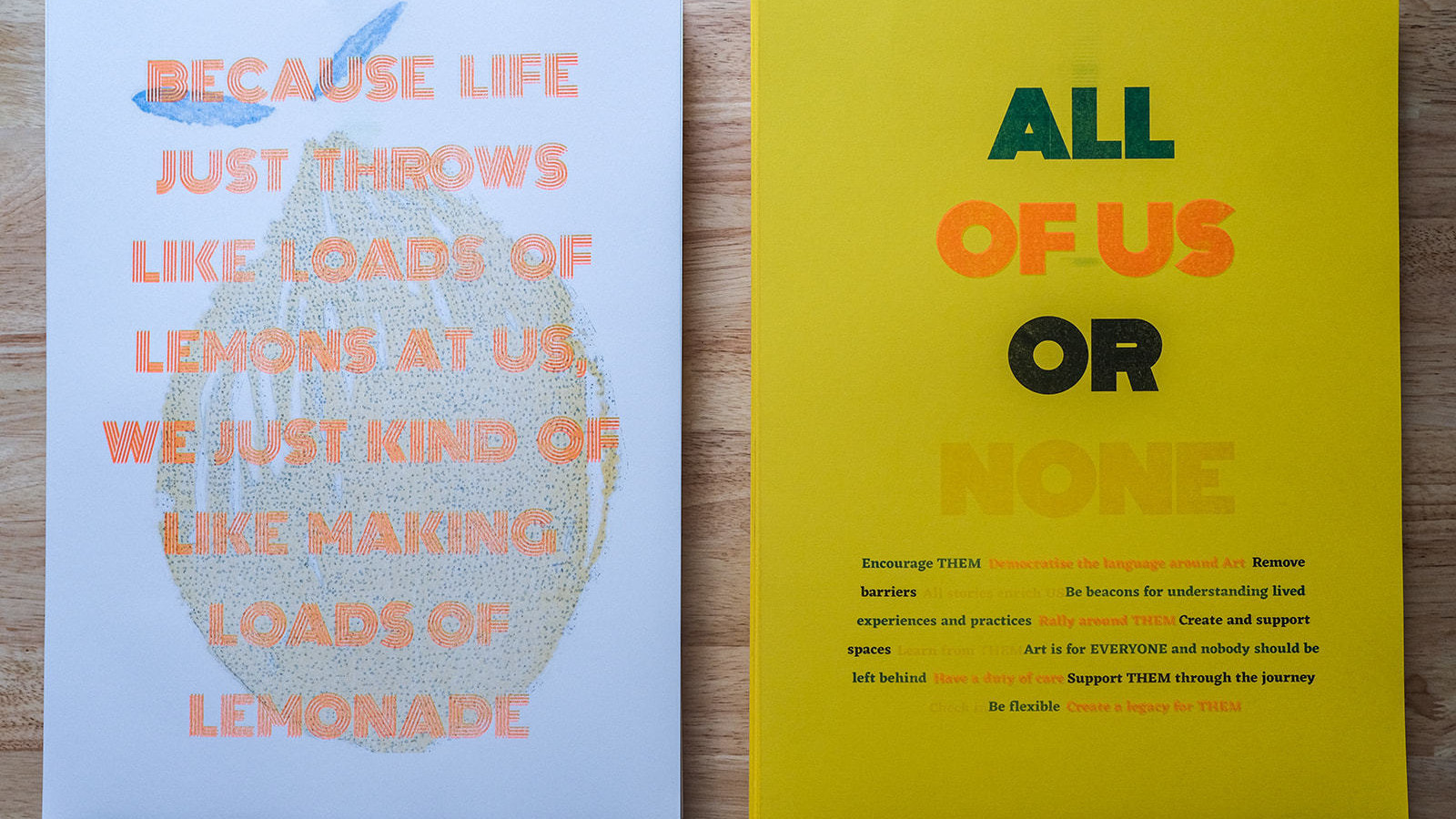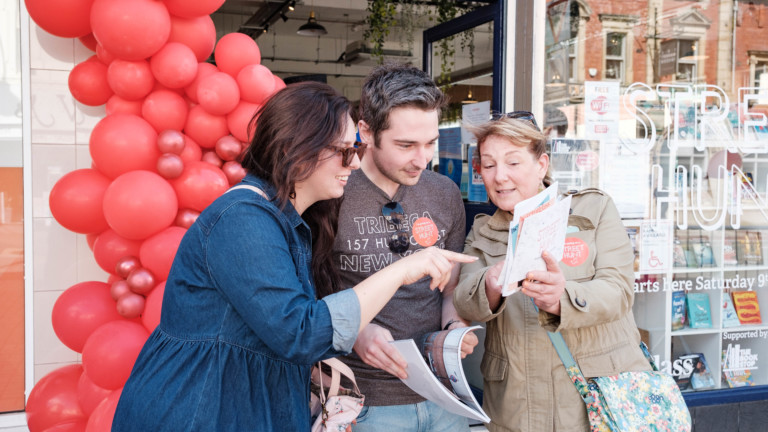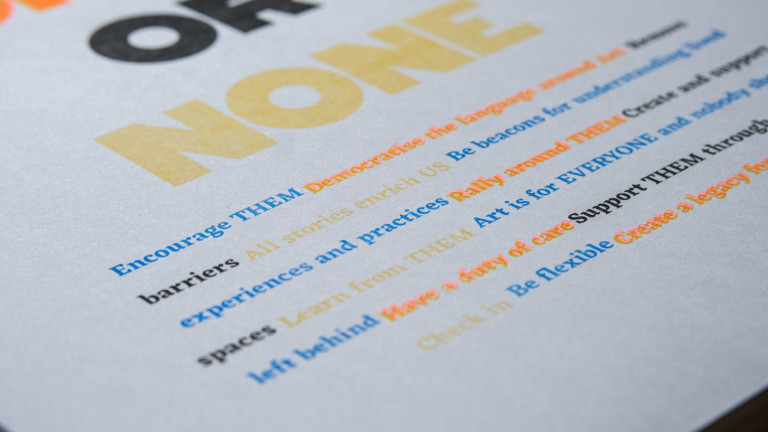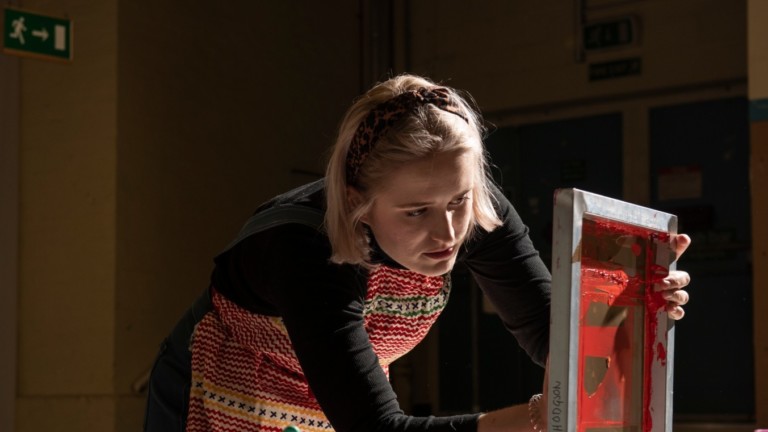In this discussion, curated by Fox Irving for Heart of Glass, a group of working-class women artists reflect on how their formative experiences have come to condition the horizons of their expectations and influence their journeys as artists. Art, it becomes clear, is shaped by power structures that reproduce through spaces and practices. The cultures of schools and universities, galleries and theatres, which sanctify particular modes of knowledge and behaviour, can bring to the surface a deep shame and senses of not-belonging for those who haven’t learned middle-class cultural norms and ways of being. Embodied and instinctive working-class modes of knowledge, especially those rooted in female experience, are rarely recognised and rewarded. Gatekeeper tendencies towards offering morsels and fringe opportunities to working-class artists, and paying nothing or very little, amplify the sense that arts careers are not viable for working-class women.
As Maria Paul reflects during the podcast, growing up as a working-class black girl, the arts, ‘just didn’t happen in my world’. Instead, she relied on everyday creativity, make believe and role-play to meet her creative desires. Such forms of everyday expression are universal, and might be framed as art and performance making, but are almost entirely overlooked in formal measurements of arts engagement, which frequently cast working-class people as ‘unengaged’ or ‘hard to reach’.
What does it mean to be a young working-class woman? What does it feel like? Why is that important when thinking about art?
The podcast sheds some light on these questions. Class relations, it reveals, are relations of space, time, race, economics, shame and resilience, which are deeply felt and exceptionally personal — but also rooted in the public and private spheres through which we come to know ourselves.
Hearing these women reflect on their own formative years, brought to mind an image from my own life: A photograph, taken when I was teenager that I’ve carried with me wherever I’ve lived — I am fourteen in the picture, so the year must have been 1997. Probably, it was taken on a weekend night — possibly a Saturday. Most likely, given the angle (the photographer is taller than us, and the camera is pointed down slightly, to capture our faces at eye level) it was taken by my dad. In the photograph, three of my friends and I are dressed-up for a night out. We look unbearably young — judging by our outfits, we are obviously desperate to appear grown-up. We are stood in the front room of my parents’ house, smiling. I am wearing a two-toned black and red strapless top, cut to my midriff (a boob-tube, so-called because all it covers is your boobs, in a thin tubular strip). My friends are dressed in similar scant, glamourous clothes — probably we shopped for them together that day, as we often did, at Woolwich Market, where you could get knock-off versions of high street fashions for a quarter of the price. Our faces are made up, heavy with foundation, eyeliner and Rimmel’s Lasting Finish Lipstick in Coffee Shimmer. We look excited. We are on the cusp of adulthood, and in a hurry for experiences that’ll put some velocity into the transition.
In that image, my friends and I are trapped under the camera lens, frozen in time — on the threshold of becoming who we are now. When I look at it, I have the sickly-sweet swing of nostalgia, almost too poignant to bear. Lately, that terrible nostalgic sweetness has been undercut with fear, and a very precise paternalistic feeling, of wanting to reach in and tell us about life. Of wanting to protect us all from what is to come: the lot of young women who society cares little about. If that sounds dramatic or clichéd, it’s the closest I can get to the truth of my feelings. To be a teenage girl is to grapple with complicated feelings. Feelings that are neither good nor bad, but sites of pleasure and pain. Paradoxical feelings: wonderful and terrible things stirred up into a rich soup that becomes the texture of life.
If teenage girls are complex and frequently misunderstood — this is amplified for working class teenage girls and young women, who are frequently invoked in popular and political discourse as stupid, vulnerable, sexually available and dangerous.
The sociologist Imogen Tyler demonstrates how this discourse calcifies in the public figure of the ‘chav mum’ — the idea of the young, feckless working-class mother, who scrounges welfare benefits and offers little back to society (1). Tyler offers the fictional character Vicky Pollard in the comedy television series Little Britain as a particularly persuasive example of the chav mum figure. A fifteen-year-old from Bristol, Pollard has many children fathered by numerous men. Her children are a variety of races, and in one memorable incident she sells a child for a CD by the popular boy band Westlife. Tyler notes how Vicky Pollard (despite being fictional and a parody) became a cultural touchstone in the first decade of the twenty-first century: a means by which to rationalise economic and social policies that punish working-class women. Although the single mother had been a target of national abjection since at least the 1980s (2), such policies intensified in the second decade of the century, as international austerity measures levelled in the wake of the 2008 recession resulted in cuts to welfare benefits and public expenditure which ‘disproportionately affect women’ (3). In the lead-up to these policies, the chav mum, Tyler tells us ‘moved relentlessly through the public culture on a wave of mockery, contempt and disgust’ (4), justifying such measures that exacerbated inequality.
Figurations of the ‘chav mum’ are repeated in fictional reputations in UK television, and have done so since at least the late twentieth century: notable examples include the character Waynetta Slob, from the sketch television series Harry Enfield and Chums, and Bianca Jackson, from the long-running British soap opera EastEnders — both also white, working-class women with racially mixed children, portrayed as variously disgusting, emotionally volatile and immoral — albeit often with far more nuanced and at time warm undertones than the depiction of Vicky Pollard, which is utterly nasty. These kinds of representations have impacts not only on policy, but also on the ways that working-class girls and young women see themselves, engage with the world and are seen and treated by those around them. When we left my parents house and were groped and wolf-whistled by adult men, this was partly because we lived in a society that gave the message that our sexual availability was our worth.
In the podcast, the artists speak about cultural barriers they have faced. Jasmine Shigemura Lee tells us that she had little chance to see theatre before she began attending workshops at the Camden Roundhouse, while Amina Atiq discusses ‘making lemonade from lemons’ through the necessity borne of working-class hardship. What sits underneath these discussions is the fact that attitudes towards working-class young people are inevitably tied up with the pervasive, negative stereotyping that proliferates in our cultural and political landscape.
The complex, deep, personal feelings that are the stuff of our lives come from a wider culture.
It is possible for a teacher to ‘eliminate’ the possibility of an arts career for a working-class girl (as Maria describes in the podcast) because working-class young women are denigrated at every turn. Of course, the power of teachers, mentors and other artists to push against the messages of the culture is possible too — as shown here. Listening to these women, the importance of recognising working-class talent, of finding ways to allow young people to see and display their worth, becomes clear.
‘When you own your own unique skills and experience,’ Adlam SGS says, ‘And you see yourself as other people do, you realise that actually, you have a lot to be proud of.’ Our job now, as podcast listeners, is to help young women own their lived experience, and find pride and motivation in all their unique complexity.
References
1) Tyler, Imogen. 2008. “Chav Mum, Chav Scum”: Class Disgust in Contemporary Britain. Feminist Media Studies, 8(1): 17-34. (See also: Beswick, Katie. 2020. ‘Slaggy Mums: Class, Single Motherhood and Performing endurance.’ Keywords. 18. 94-113)
2) Skeggs , B. 2005, ‘ The making of class and gender through visualising moral subject formation ’, Sociology , 39 ( 5 ): 965–82
3) Durbin, S., Page, M., and Walby, S. 2017. Gender, Equality and ‘Austerity’: Vulnerabilities, Resistance and Change. Gender Work and Organisation. 24(1): 1-6
4) Tyler, Imogen. 2013. Revolting Subjects: Social Abjection and Resistance in Neoliberal Britain. London: Zed Books. 165
Katie Beswick is a writer and academic who's research interests include performance on and about council estates, representations of female desire, and street performance culture. They currently teach at Wimbledon College of Art.


 News
News Short Read
Short Read
 Resource
Resource